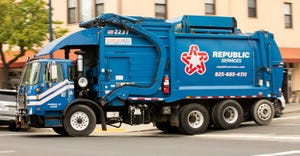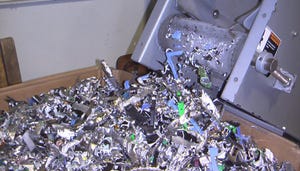Troubleshooting Trucks: Paving The Way To Efficiency
December 1, 1996
Bob Deierlein
Technological advancements are greasing the way for inreased efficiency in operating today's trucks. Wise fleet managers are carefully evaluating the updates in tire retreads, brakes, batteries and lighting to see if the extra features are useful in their operation.
Get Lit Lighting systems require the highest repair frequency of all truck components (see table on page 44). However, significant improvements in headlamp design have resulted in extended lamp life.
According to The Maintenance Council (TMC), Alexandria, Va., survey, original equipment headlamps now boast a 200-day average life, while replacement lamps last approximately 540 days.
Light-emitting diode (LED) lighting is another developing technology which can lower alternator requirements and reduce the parasitic load on the engine. But durability is their main feature, with LEDs lasting 100,000 hours versus 3,000 hours for incandescents resulting in less vehicle downtime.
LED's performance characteristics include:
* power consumption reduction and voltage drop;
* faster rise and decay times, (24 extra feet of stopping distance at 60 m.p.h.) and;
* lower lamp operating temperature.
Additionally, the LED lamp's low power consumption rate - approximately 10 percent of a standard incandescent bulb draw - reduces battery and alternator system drain.
LEDs' high price, the main deterrent to specing, slowly is being eliminated. Truck-Lite, Falconer, N.Y., recently announced a price reduction, and its competitor Grote, Madison Ind., agrees that prices will continue to plummet. However, Grote notes that fleets must use a cost-per-mile basis instead of cost-per-unit to analyze LED performance.
Many fleets agree that the LED exterior lights' time has come. American Freightways, Harrison, Ark., reports that LED lamps will more than pay for themselves with their 10-year service life. For example, in the life cycle of a 12-year trailer, you have to replace conventional lights about three times.
LED lighting is compatible with existing incandescent lighting and can be retrofitted into existing wiring with a simple change to sealed LED connectors, said Truck-Lite's Paul Kahanic. However, he notes that the "ultimate solution for long-term reliability and a cost-effective lighting system is the combination of LED lights and a high-quality sealed harness system."
When you consider reduced operating costs, a return on investment calculation for LEDs shows that they pay for themselves in less than one year, according to Gary Durgin of Dailight Corp., Manasquan, N.J.
Don't Fear Retreads In 1995, approximately 32.9 million retreaded tires were sold in North America, including 7.9 million retreaded light truck tires and 17.6 million retreaded medium and heavy truck tires.
According to industry experts, a retread's lower cost is the single most important reason for its popularity. Since a quality retread can be purchased for about one-third the cost of a new tire, retreads can save up to $1,000 per vehicle in annual tire purchase cost. A quality tire can be retreaded an average of three times.
Although durability is an issue with retreads, according to the Tire Debris Task Force, representing truckers, retreaders, tire manufacturers and government agencies, most of the highway tire debris is caused by nail punctures - something that can happen to any tire. Problems caused by underinflation, overloading, tire mismatching on dual-wheel positions and other improper maintenance and inspection also caused retread failure.
The city of Louisville, Ky., has an aggressive retread tire program on its fleet of 60 waste trucks and other vehicles. The program is registering savings, according to operations manager Michael Riley, especially on tandem axle trash packers which generally wear the tread off in two to three months. A new tire replacement costs $244, compared to the retread's $119.
Riley estimated that 60 percent of the city's waste and dump trucks will use retreads soon, and the numbers will rise as other vehicles are added. In the past several months, more than 88 percent of the tires purchased for the city's waste hauler and dump truck fleet were retreads.
Not all casings are equally suited for retreading; high quality new tires ensure the best possible casings for retreading. Premium casings can be retreaded an average of three or four times.
Critical Timing Too many truck fleet operators wait until tire tread depth has been worn down past the point of safety before retreading. Waiting until the tire tread has reached the legal minimum of 21/432 inches or 41/432 inches in front wheels can be risky.
Other causes of premature casing loss include:
* inadequate attention to air pressure and maintenance;
* overloading beyond the tire's ratedcapacity;
* using tires which are unsuited for particular applications;
* lack of vehicle maintenance, especially wheel alignment and front tire balancing; and
* cracking caused by weather exposure.
Casings also can be saved by paying attention to proper tire repair.
The retreadability of a worn truck tire casing is not solely a factor of age.
The casing condition can be affected by:
* the application - long haul, on/off road, waste removal;
* the type of equipment, such as single-axle or tandem tractor;
* the truck's maintenance level; and
* the tire's treatment during operation.
A new tire in a severe application with poor attention to equipment and tire maintenance may be "old" well before its time, and may not be retreadable. However, an older tire which has not been subjected to overloaded or underinflated conditions and which has been on regularly maintained equipment is likely to handle multiple retreads.
Good Tire Health Periodic checks for proper inflation, matching and irregular tread wear are essential for successful retreading.
An underinflated tire deflects more than a properly-inflated tire, which affects rolling resistance and thus, increases tread surface wear and fuel consumption.
As a rule of thumb, tire life will decrease 10 percent for every 10 percent it is underinflated. For example, a tire that normally requires 30 pounds per square inch (psi) of air is good for 60,000 miles and will experience only 90 percent of its tread life if it contains 27 psi.
Since the amount of air in each tire affects weight distribution between the wheels, an underinflated tire doesn't carry its full share of the load - affecting loading, traction, steering, alignment and braking. It also may cause steering pull when driving or braking. An underinflated tire will break traction more easily than one that is properly inflated, which can result in skidding during braking or hard cornering or can cause wheel spin with acceleration.
The ambient air temperature is another factor that even professional technicians forget. A tire's air pressure fluctuates about one pound for every change of 10 degrees. Most tire inflation pressures are specified for an ambient temperature of 70 degrees F.
Future Brakes Changes are occurring in anti-lock breaking systems (ABS), automatic slack adjusters, brake lining classifications and markings, and the popular air discs and electronic braking systems (EBS).
The more futuristic air disc brakes and EBS are moving toward improvements. Air disc brakes are immune to water fade because of smaller friction surfaces and the high clamping force that "squeezes" water from rotors.
As a result, stopping capability is not reduced when they are wet and a more consistent braking torque results over a wide range of speeds.
EBS' advantages include enhanced performance, simpler maintenance (linings wear at the same rate, capability to compensate for different loads and reduced costs), detection and compensation for brake fade and the ability to notify the driver of critical wear.
In addition, shorter stopping distances - possibly 10 percent - will lead to reduced driver fatigue and more confidence when braking. However, these components are still in the conception phase: Feasible air discs are coming, maybe as early as next year, but don't look for EBS anytime before the century's end.
Stay aware of ABS since they are being mandated over the next few years for all vehicles, including hydraulically-braked trucks. Don't worry: The government decided not to mandate that older equipment be retrofitted with ABS.
Most drivers will need to inspect the dashboard closely to detect whether their vehicle is ABS-equipped.
Despite ABS, drivers need to allow the same stopping distance for varying conditions. They should know ABS' capabilities and how ABS-equipped vehicles should be driven.
Help From A Manufacturer Rockwell Automotive, Troy, Mich., recently reported that today's vehicles are moving faster, have less drag, and boast increased tractor and gross vehicle weights when compared to the vehicles of the '70s.
Simultaneously, vehicle dynamics are changing faster than brake system designs. For instance, the industry standard has been the 15-inch by 4-inch steer axle brake and 16-inch by 7-inch drive and trailer axle brakes.
Now, manufacturers are altering their braking standards and are improving brake heat dissipation, reducing fade and lengthening the life of all heat-sensitive wheel-end components.
Rockwell proposes widening the brake to provide better heat dissipation and reduce brake fade. Lower brake operating temperatures also extend lining life, decreasing the number of brake adjustments required over the brake's life.
Getting A Charge Excessive battery charging and discharging causes more electrical system breakdowns than any other cause.
The amount of charging voltage, battery chemistry, driving cycle, drive time and cranking amounts all play a large part in battery life and should be factored into the specing process.
A balance between these factors is needed to keep a battery fully charged without suffering overcharge damage. Specing electrical components that work together as a system also is a must.
To improve battery life, suppliers suggest:
* developing a comprehensive recharge program;
* assign a number to the recharged battery to track recharge usage;
* determine acceptable recharge rates (fleets should recover 70 percent);
* emphasize the recharge program by using skilled shop personnel, who are experienced with test equipment; and
* manage the amount of energy discharged from the battery pack.
Three battery technologies are used today: lead-acid, gel cell and recombination. They have differing recharging capabilities at different temperatures and at differing rates of charge.
This year, one OEM introduced a gel cell battery for the cycling battery of his split battery system. Although it is accepted knowledge that these batteries have excellent cycling capabilities, they have a narrow operating window during recharge. If these batteries are overcharged, the vent will 'pop,' and the battery will fail. Fleets using this type of battery must have special charging equipment.
Many fleets continue to have battery problems because key-off parasitic loads continue to increase. These parasitic loads cycle batteries and shorten battery life and cause an inability to start, starter damage, and reduced alternator and battery life.
A dash-mounted electronic device that improves the battery and alternator life by eliminating deep cycles and starter life by locking out the starter when the engine is running should be considered.
The Programmable Cranking System Manager (PCSM) allows tailoring to individual requirements. It monitors battery voltage, the starter push button switch, rpm and oil temperature from the J1708 communications network and a calibration signal which enables the voltage calibrate function.
For outputs, PCSM will control the indication LED, starter magnetic switch and the accessory bus magnetic switch. Generally speaking, batteries with high cold cranking amp (CCA) ratings won't provide good service in deep cycling applications.
Conversely, deep cycle batteries might not provide adequate CCAs in applications that have high current starting requirements. The fleet manager must understand the characteristics that result from various battery designs.
Radial truck tire injuries up to 5 11/48 inch radially by 31/44 inch axially or 3 11/48 inch radially by 1 11/42 inch axially on the sidewall and 1 11/42 inch diameter in the crown area can be repaired routinely, according to tire repair material manufacturers. Nailholes up to 31/48 inches can also be repaired. "Outside-in" or "on-the-wheel" type repairs should not be used.
The use of proper repair materials is essential. For injuries exceeding 31/48 inches, radial section repair units should be used for radial tires; bias section repair units should be used for bias tires.
In the case of nailholes (maximum 11/44 inch for passenger tires; 31/48 inch for truck tires), the injury must be filled with a vulcanizing material to prevent injury growth or belt package separation and to protect against contamination and moisture from entering the casing. The proper repair unit should be applied to seal the innerliner.
A few years ago the American Retreaders' Association (ARA) conducted a study on strength of sidewall repairs in radial truck tires. Radial truck tires with injuries 4 inch long and 31/44 inch wide were repaired, x-rayed and subjected to increased pressure until bursting.
The ARA concluded that properly-repaired sidewall injuries have a strength equal to the surrounding tire body and provide a safe-performing product.
The Commercial Vehicle Safety Alliance (CVSA) has adopted the blue triangle logo to help identify bulges caused by sidewall/shoulder area repairs. Those bulges due to section repairs are acceptable if they do not exceed 31/48 inch in height.
Tire repairs convert damaged tires into safe and usable products. Unfortunately, not all repairable tires are repaired. Recent scrap tire surveys have shown that up to 30 percent of alleged scrap truck tires were repairable.
The average cost of a radial truck section repair is approximately $50, a bargain in extending the life of a $300 investment, while lowering the cost per mile.
You May Also Like


